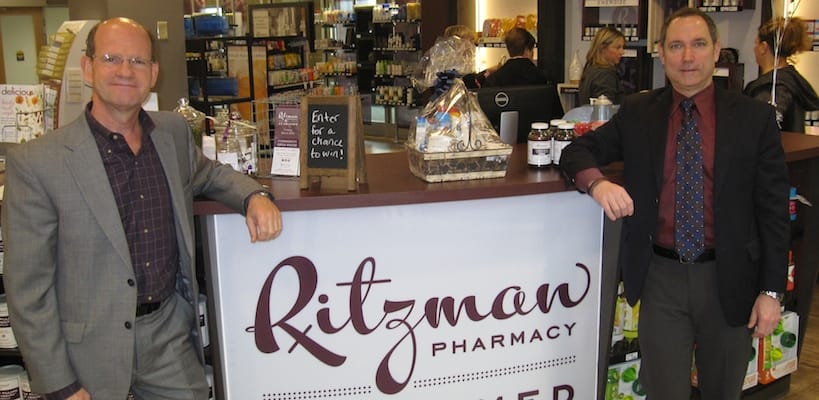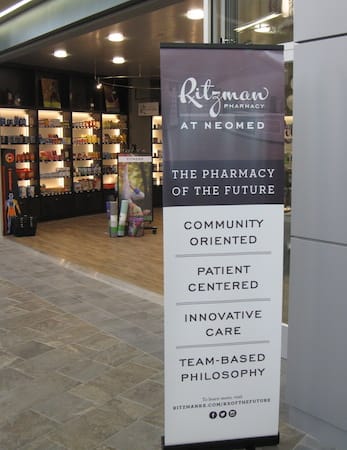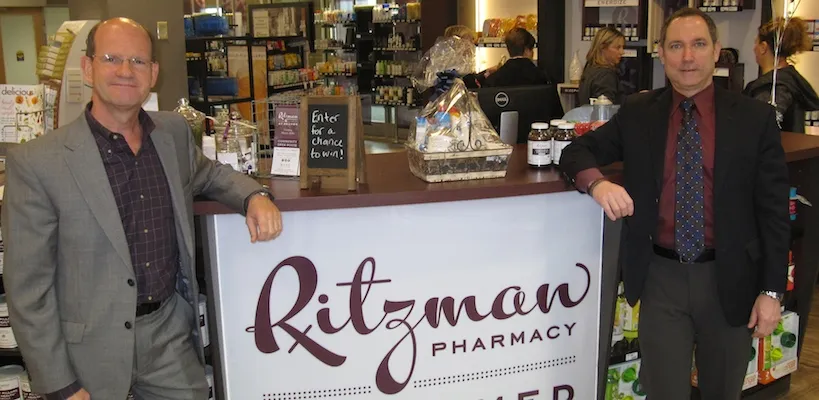
Ritzman’s Eric Graf and George Glatcz at the opening of the chain’s “pharmacy of the future” location at NEOMED.
ROOTSTOWN, Ohio — An answer to the commoditization of pharmacy has arrived here.
“The Pharmacy of the Future,” highlighting pharmacists’ clinical knowledge and services, has been opened in northeastern Ohio by Ritzman Pharmacy. With a look that is more akin to a doctor’s office than a chain drug outlet, the location is such a departure from conventional prescription counters that Ritzman chief executive officer Eric Graf calls it a “practice” instead of a store.
“You have a medical practice, a chiropractic practice, a dental practice,” says Graf. “This is a pharmacy practice. We’re trying to elevate customers’ expectations for a pharmacy interaction.”
A “concierge” greets customers at the entrance to the 4,200-square-foot site and explains the specially curated front-end offerings, which are centered on dietary supplements and homeopathic remedies. A small section also features locally made products, while side rooms are available for consultations and immunizations and interactive educational programs.
To dissociate the pharmacist from the dispensing function, the medication shelves are walled off behind the prescription counter. With the bagging of scripts out of view, pharmacists engage with patients as the medication experts that they went to school to become, says Graf. A “tech bar” on one side of the counter, integrating technology into health care, reinforces pharmacists’ enhanced status.

Graf likens the overall concept to Starbucks’ reinvention of the coffee shop decades ago, when the only choice customers had was black or cream and sugar, and price was the only differentiator between outlets.
“It’s about an experience,” he says. “We’re trying to change this into an emotional experience, just like a Starbucks is. There’s something happening here that should speak to patients in a way that says this is what a pharmacy interaction should be like. Hopefully they’ll recognize that this is how they want their pharmacy needs taken care of.”
While Starbucks charges higher prices than other coffee purveyors, Graf says the new Ritzman model can be profitable even with the preset prices and ever-shrinking reimbursement rates of pharmacy benefit managers and government plans.
The Rootstown practice, which opened last month, built a promising script count in just its first week, he said, even attracting customers who had been using a supermarket pharmacy across the street.
The site’s distinctiveness stems in part from its setting, on a medical school campus that doubles as a community gathering place with a farmers’ market and movie nights. Also on the Northeast Ohio Medical University (NEOMED) campus are a pharmacy school, science-oriented high school, and patient-centered medical home. The public can take advantage of a Sequoia Wellness fitness center, café and coffee shop, and an event space for the likes of wedding receptions. In the works is an office tower for physicians.
Such mixed-use developments, which are springing up nationwide, present an ideal locale for the Pharmacy of the Future, says Ritzman chief operating officer George Glatcz. NEOMED’s integrated services are an answer to the shortage of primary care physicians and the increased demands on the health care system from the Affordable Care Act, he says.
“That’s were the future is happening,” he says of integrated service sites. “It’s population health management. It’s all happening in one location.”
At the same time, Glatcz says the new Ritzman model — which the company is rolling out across its operation — can work at the corner of “Fifth and Main.” It can appeal to seniors who are daunted by multiple prescriptions as well as mothers serving as the health care providers for their families or Millennials who want to go over their FitBit readings at the tech bar with the pharmacist.
The tech bar will offer tutorials on body temperature devices and TENs units that snyc to smartphones. “It will constantly evolve with new products,” says Ritzman marketing director Christina Cyrus. “This will be evergreen, and we’ll sustain it with the latest in technology.”
She adds that the pharmacist will reinforce the practice’s commitment to the latest technology with a tablet with apps like Boiron’s for homeopathy. “Everything’s at the fingertips of the pharmacist,” says Cyrus.
“There’s a lot of confusion about health and wellness apps,” notes Glatcz. “Why can’t the pharmacist be the person who guides people through that process?”
The front end’s design is based on addressing the two most common health goals sought by Ritzman’s customers: increased energy and weight loss. Departments with supplements, essential oils, yoga mats, and aromatherapy and homeopathic products along with mainstream H&BAs are labeled “Revives” and “Remedies.” The locally manufactured products — including toiletries, crafts and giftware — are found in the section called “Restores,” which signals Ritzman’s dedication to revitalizing the local economy.
Overall, the layout provides “a platform to tell a story that is different than a normal pharmacy practice story,” notes Graf.
Glatcz says he knows of many chain pharmacy customers who don’t know who their pharmacist is and deal only with technicians.
“The business has become so commoditized that half the time patients don’t even talk to the pharmacist. We’re after a higher-quality experience with better care. The Affordable Care Act and lack of GPs is putting a premium on preventive and post-hospital care. What better role can a pharmacist play in the community?
“Fifty years ago people called the pharmacist ‘doc.’ We’re going back to the future. We’re pioneering vintage care with 21st century technology.”
For pharmacists, he adds, the new model can improve job satisfaction. “Pharmacists can too often feel like they’re part of a production line. But they went to school to practice health care.”







